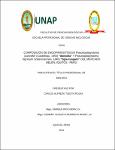Composición de endoparásitos en Pseudoplatystoma punctifer (Castelnau, 1855) “doncella” Y Pseudoplatystoma tigrinum (Valenciennes, 1840) “tigre zungaro” del mercado Belén, Iquitos - Perú
Abstract
El objetivo del presente trabajo fue evaluar la fauna parasitaria de dos especies
de peces, Pseudoplatystoma punctifer “doncella” y Pseudoplatystoma tigrinum
“tigre zungaro” procedentes del mercado Belén – Iquitos – Perú, entre los meses
de enero a octubre del año 2019. Se realizó mediante la observación, búsqueda
e identificación de la fauna endoparasitaria en estas dos especies (50 individuos
por cada pez procedentes del mercado Belén). El análisis de los peces se llevó
a cabo en el Laboratorio de Parasitología y Sanidad Acuícola del Instituto de
investigaciones de la Amazonia Peruana (IIAP). En el presente estudio fueron
identificadas 6 nemátodos (4 géneros y 2 especies) sin haber encontrado otros
grupos parasitarios, siendo 4 de ellos endoparásitos con potencial zoonótico
(Anisakis sp., Contracaecum sp., Eustrongylides sp. y Pseudoterranova sp.); así
mismo se realizó el cálculo de los índices parasitarios para ambas especies
teniendo al género Anisakis sp como dominante en estos índices con una
prevalencia de 52%,52%; intensidad de 156, 81 intensidad media de 6.0, 3.12 y
abundancia media de 3.12,1.62 respectivamente; para la correlación del tamaño
y peso de los ejemplares con la abundancia parasitaria se obtuvo
estadísticamente una correlación positiva para tigre zungaro y una negativa para
doncella. Se concluye que la fauna de endoparásitos encontrados en
Pseudoplatystoma punctifer y Pseudoplatystoma tigrinum analizadas en el
presente estudio está representada por nemátodos. This study aimed to evaluate the parasitic community of two species of
fish, Pseudoplatystoma punctifer (Spotted Tiger Shovelnose Catfish)
and Pseudoplatystoma tigrinum (Tiger Shovelnose Catfish) from the fish market
of Belen, Iquitos, Perú, from January to October 2019. It was carried out by
observing, searching and identifying the endoparasitic fauna in these two species
(50 individuals for each fish from the Belén market). The analysis of the fish was
carried out in the Laboratory of Parasitology and Aquaculture Health of the
Research Institute of the Peruvian Amazon (IIAP). In the present study, 6
nematodes (4 genera and 2 species) were identified without having found other
parasitic groups, 4 of them being endoparasites with zoonotic potential (Anisakis
sp., Contracaecum sp, Eustrongylides sp and Pseudoterranova sp.); Likewise,
the calculation of the parasitic indices for both species was carried out, having the
genus Anisakis sp as dominant in these indices with a prevalence of 52%, 52%,
intensity of 156, 81 average intensity of 6.0, 3.12 and average abundance of 3 12
, 1.62 respectively, for the correlation of the size and weight of the specimens with
the parasite abundance, a statistically positive correlation was obtained for the
Zungarian tiger and a negative one for the maiden. It is concluded that the
endoparasite fauna found in Pseudoplatystoma punctifer and Pseudoplatystoma
tigrinum analyzed in the present study is represented by nematodes.
Collections
- Tesis [421]


